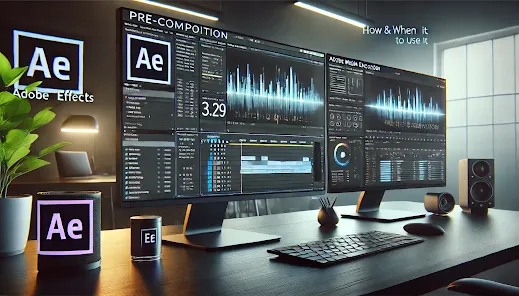How to Render in Adobe After Effects Using Media Encoder | Best Export Settings
Introduction
Rendering videos in Adobe After Effects using Media Encoder is the best way to achieve high-quality exports with efficient compression. It allows you to export in various formats while maintaining smooth performance.
In this guide, we’ll cover:
✅ How to render videos using Adobe Media Encoder
✅ Best export settings for different platforms
✅ Tips for optimizing rendering speed
How to Render Using Adobe Media Encoder
Rendering with Adobe Media Encoder provides flexibility and better output options compared to the Render Queue.
Step 1: Send Composition to Adobe Media Encoder
- Open your After Effects project and select the composition you want to export.
- Go to Composition → Add to Adobe Media Encoder Queue.
- Adobe Media Encoder will open automatically with your composition in the queue.
Step 2: Choose the Best Export Format
Adobe Media Encoder offers a variety of formats. The most commonly used format is H.264 (MP4), ideal for online platforms.
- H.264 (MP4) – Best for YouTube, Vimeo, and social media
- MOV (ProRes/Animation Codec) – High-quality for professional use
- GIF – Best for short animations
- FLV – Used for Flash content
Step 3: Adjust Export Settings
- Click on the Preset dropdown and select:
- Match Source - High Bitrate for best quality
- YouTube 1080p Full HD for online videos
- Custom Settings for specific needs
- Modify bitrate settings to control file size and quality.
- Set frame rate and resolution based on platform requirements.
Step 4: Select Save Location
- Click on the Output File name and choose your desired save destination.
Step 5: Start Rendering
- Click the Green Play Button to begin rendering your video.
- Adobe Media Encoder will process your file while allowing you to continue working in After Effects.
Best Export Settings for Different Platforms
Each platform has specific requirements for optimal video playback. Here are the recommended settings:
YouTube & Vimeo
- Format: H.264 (MP4)
- Resolution: 1920x1080 (Full HD)
- Frame Rate: 30fps or 60fps
- Bitrate: 10-15 Mbps
Instagram & Facebook
- Format: H.264 (MP4)
- Resolution: 1080x1080 (Square) or 1080x1920 (Vertical)
- Frame Rate: 30fps
- Bitrate: 5-10 Mbps
Professional & Archive Use
- Format: MOV (ProRes or Animation Codec)
- Resolution: Full HD or 4K
- Frame Rate: Original Frame Rate
- Bitrate: High (Uncompressed or Lossless)
Tips for Faster Rendering in Adobe Media Encoder
✅ Use GPU Acceleration – Enable hardware encoding for faster processing.
✅ Lower Bitrate When Necessary – Helps reduce file size while maintaining quality.
✅ Use Pre-Rendered Files – Convert heavy elements into image sequences before final export.
✅ Close Unnecessary Applications – Frees up system resources for a smoother rendering process.
✅ Use a Faster Storage Drive – SSDs speed up rendering and exporting times.
Conclusion
Rendering in Adobe After Effects using Media Encoder is the best method for high-quality exports with optimized settings. By following these steps and using the best export settings for your needs, you can achieve professional results efficiently.
🎬 Start rendering your videos with Adobe Media Encoder today! 🚀

